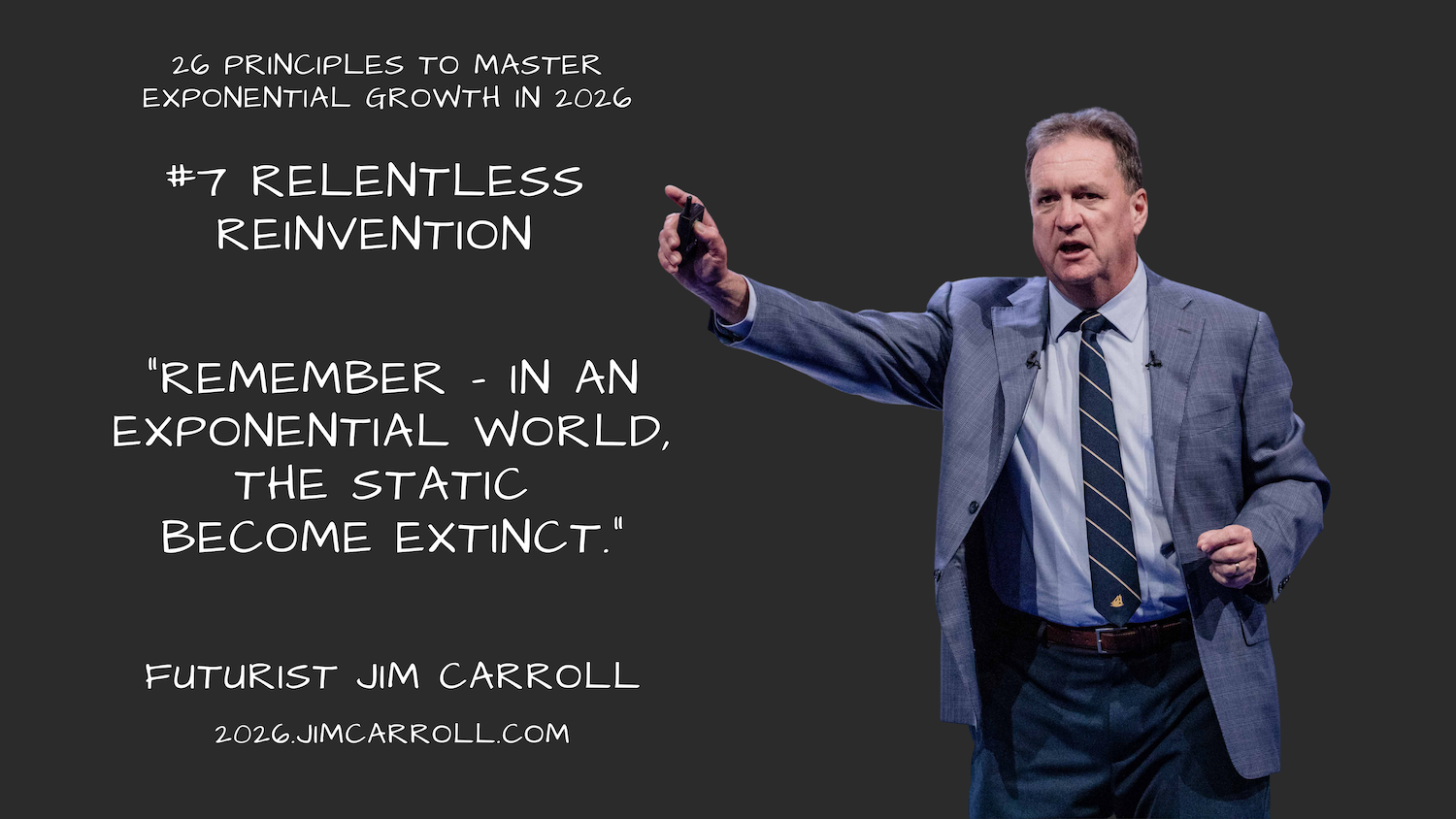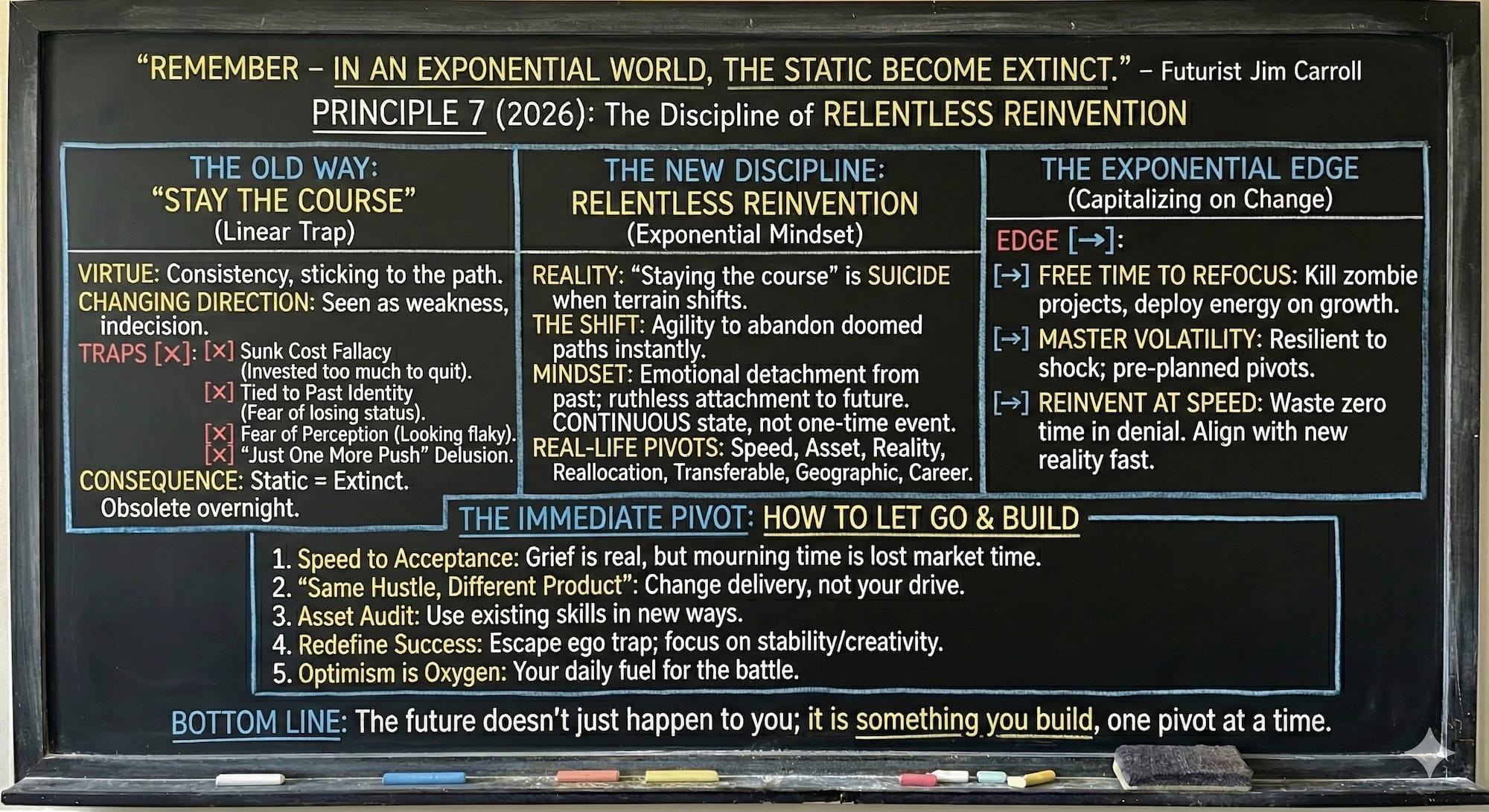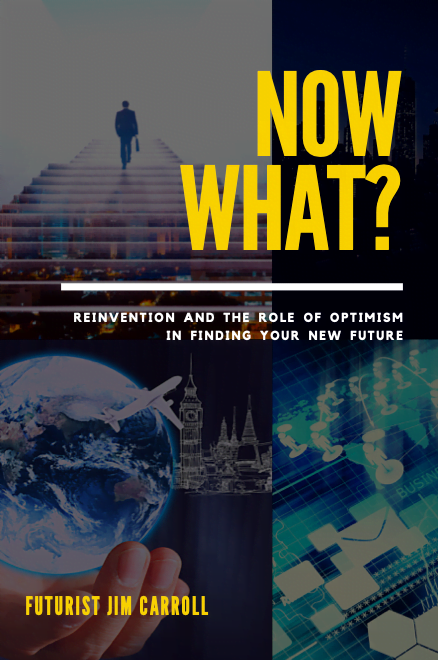"Remember - in an exponential world, the static become extinct." - Futurist Jim Carroll

Futurist Jim Carroll is writing his end-of-2025 / introduction-to-2026 series, 26 Principles for 2026. You can follow along at 2026.jimcarroll.com. He welcomes your comments.
Day 7? Let's focus on Relentless Reinvention, and why "staying the course" is the most dangerous strategy of all
Days 1 to 6? We've reset your clock, cleared your path, built your courage, turned on your radar, accelerated your learning, and embraced rapid mistakes.
Now, we arrive at the hardest emotional discipline of them all: knowing when to change - and doing the change.
In our old, slow-moving linear world, "staying the course" was a supreme virtue. Once you set a career path or a long-term leadership strategy, you stick to it. Changing direction mid-stream was seen as a sign of weakness, indecision, or flakiness.
But in an exponential world, "staying the course" when the terrain is fundamentally shifting beneath your feet isn't grit; it's suicide.
Here's your chalkboard summary!

When technology, industries, or market dynamics shift exponentially, your current role, skill set, or leadership approach can become obsolete overnight. The most successful leaders in 2026 won't be the ones who cling the hardest to their past identities; they will be the ones with the agility to abandon a doomed path instantly and reallocate their personal energy to a new one.
In that context, the discipline you must master is Relentless Reinvention. Reinvention? It's often known as 'the pivot.'
What Reinvention Looks Like in Real Life
It is easy to discuss the concept of the "pivot" in the abstract—as a strategic necessity on a whiteboard. It is much harder to recognize what it looks like in the trenches of real life.
In my book Now What? Reinvention and the Role of Optimism in Finding Your New Future, I documented the journeys of individuals who faced this exact precipice, with several of the stories looking at their pivot during the pandemic of 2020. They didn't just "change jobs"; they fundamentally reinvented their skills, their time, and their identities to align with a new reality. You can get the book here.

Here is what Relentless Reinvention looks like in practice:
Beth Cooper: The Speed Pivot. When the event industry collapsed, she moved through the "stages of economic grief" faster to get to acceptance in less than a week. Instead of waiting for "normal" to return, she pivoted immediately to digital event production, proving that speed of reality alignment is the ultimate survival skill.
Tom Morley: The Asset Pivot. Tom, a member of the 80s band Scritti Politti, took his world-class drumming skills and reallocated them from the rock stage to virtual corporate team building - a pretty wild pivot if you think about it. He illustrates that you don't always need new skills; you often just need a new delivery mechanism for the talent you already possess. That's a pivot!
Jeffrey Lee Campbell: The Reality Pivot. Jeffrey, once a guitarist for Sting's touring crew, provides a lesson on escaping the sunk cost fallacy. He warns that "it is reckless... to presume that the success that you have today will guarantee you similar success tomorrow". He mastered the pivot by redefining success itself, moving from the volatile highs of touring with Sting to a stable, creative career on Broadway.
Randy Kearse: The Reallocation Pivot. An ex-con, Randy embodies the shift from a terrible past to a brighter future. After years of incarceration, he refused to be trapped by his past, reframing his journey with a powerful mantra: "The same hustle but with a different product!" He reallocated his drive from the streets to a new life as an author and motivator. His stories of selling books on the New York Subway provide powerful insight into the hustle often demanded by "the pivot."
Keith Pelzer: The Transferable Pivot. Keith, a Grammy-nominated producer turned pastor, didn't wait for churches to reopen. He realized "pastoring is now about content creation" and transferred his production mastery to create a sophisticated virtual presence. Read the story of his virtual visits with 80-year-olds to provide them spiritual warmth, and you come away with the power of the pivot.
Nick Inglis: The Geographic Pivot. Nick, a fitness strength coach, stopped serving just his local gym when lockdowns hit and immediately built a virtual studio to train clients globally, from Dubai to Singapore. His philosophy is the definition of the exponential mindset: "If you are not evolving, you are dying."
Phil de Wolf: The Massive Career Pivot. Phil shatters the linear myth. He pivoted from a professional accountant career to that of a firefighter because he refused the "predictable linear path". He didn't stop there—he pivoted again to become an emergency management specialist, proving that reinvention is a continuous process.
Keep these stories in mind - I'm going to come back to them in part 4.
1. The Exponential Mindset
So, what is an exponential mindset all about?
It's a shift in thinking, from viewing a change in direction as a "failure" to viewing it as a necessary evolution based on new data!
Accomplishing it involves a pretty profound emotional detachment from your past identity and a ruthless attachment to your future, new one. It's about personal reinvention. It's about developing the capability to recognize when your current path has reached a dead end, and having the capability to kill the project, change your career, or shift your outdated mindset immediately to chase the next opportunity.
It is coming to understand that reinvention is not a one-time event, but a continuous state of being.
2. The Linear Trap
Are you ready for this exponential world? Maybe not, because personal reinvention is hard! It seems we are wired to be trapped in our world through several common beliefs. Ask yourself if you are trapped by these common anchors:
- You aren't able to get away from what you've invested in your past. You've got a paralyzing belief that you must continue down a failing career path or project simply because of the time, money, or education you have already invested in it. You throw good years after bad to avoid admitting the initial investment is gone.
- You are far too tied to your past success, not your future one: You have tied your professional identity or reputation to a specific title, role, or industry. Killing that previous version of yourself feels like a loss. You’d rather go down with the ship than admit you were the captain who steered it wrong.
- You worry about perception. You worry that changing your career direction or leadership style makes you look indecisive or unreliable to your peers. You prioritize the appearance of consistency over the reality of market alignment.
- You get into the "just one more push" delusion: The mistaken linear belief that if you just try a little harder at the old way of doing things, the exponential tide will turn back in your favor.
3. The Exponential Edge
When you master the idea of relentless reinvention, you stop investing your personal energy in dead ends and start capitalizing on change. You gain:
- more free time to refocus. By rapidly killing zombie projects, outdated roles, and failing strategies, you instantly free up your mental energy, time, and talent to deploy on high-growth opportunities. You stop feeding your past to starve your future.
- You get better at mastering volatility. You become resilient to shock. When an unexpected market shift happens (a new technology renders your role obsolete), it doesn't break you; it simply triggers a pre-planned pivot. Your career is built to bend, not break.
- You can reinvent at speed. While peers are holding endless meetings trying to "save" a dying approach, you have already aligned your skills and focus with the new reality of the world around us. You waste zero time in denial.
4. The Immediate Pivot
Reinvention requires emotional courage and a systematic approach to letting go.
How do you get there? Let's go back to the powerful reinvention stories in my Now What? book.
- Speed to acceptance is your greatest competitive advantage: The "grief" of losing a career or business model is real, but the time you spend mourning is time lost to the market. Move through shock, denial, and anger to acceptance in record time. I talk about this A LOT!
- "Same hustle, different product": That's the key lesson from Randy. You do not need to change who you are, only what you deliver. Your internal motivation, your personal drive, is your greatest asset. Don't kill the hustle; just change it to a different future.
- Use what you have (the asset audit): Don't delay pivoting because you think you need new, foreign skills. Usually, you just need to use your existing toolkit in a new way.
- Redefine success to escape the ego trap: If you cling to your old title, you will sink with the ship. Redefine success not as "fame" or "past status," but as stability and creativity in the new reality.
- Passion can be re-purposed: Your pivot doesn't have to be a cold business decision. Stack two seemingly unrelated passions to create a niche of one.
- Crisis removes boundaries: When the world shuts down locally, it opens up globally. A pivot often allows you to trade a world of small opportunities for bigger ones.
- Know that 'serendipity' is a strategy!: The best pivots are often zig-zags. Don't worry if your pivot doesn't make sense on a traditional résumé. If it aligns with the reality of the market, it is the right move.
- Optimism is oxygen: Reinvention is a daily battle. Without a core reserve of optimism, aka the "vitamin D of the future," you will run out of energy before you complete the turn.
I've learned all these things - and write about it in the book (as well as in these daily posts. When my world of live events crashed, I didn't wait for someone to "fix" my future. I realized that "no one is in charge of your future, except for you." I became a broadcaster, producer, and technician overnight. I had to accept that my old life was gone and that "optimism is the energy that lets us do what needs to be done."
Bottom line?
The future doesn't just happen to you; it is something you build, one pivot at a time!
That's the thinking you need as we go into 2026.
Futurist Jim Carroll has reinvented his future multiple times throughout his career, considering it to be just like a regular software upgrade.

